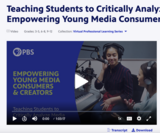An overview of how the Dewey system is designed. The types of content found in the ten categories. Followed by an assessment quiz-game.
- Subject:
- Media and Communications
- Material Type:
- Lesson
- Author:
- Utah Lesson Plans
- Date Added:
- 10/29/2021
An overview of how the Dewey system is designed. The types of content found in the ten categories. Followed by an assessment quiz-game.
Grades 3-5The lesson focuses on the importance of music in media.

Designed for middle and high school teachers, we’ll consider how to tackle misinformation, how to analyze digital media, and why it’s important for your students. Robert Costa is the Moderator of Washington Week, the Peabody Award-winning weekly news analysis series on PBS. Costa is also a full-time national political reporter for The Washington Post, where he covers Congress and the White House and regularly travels the country to meet with voters and elected officials.
Led by PBS Digital Innovator All-Star Leigh Herman and PBS Station Representative Mary Anne Lane, this session highlights exciting resources and models that you can immediately implement in your classroom.
Prioritizing fun, engaging, and accessible tools for your students, the series will highlight techniques for analyzing media, and amplifying student voice through authentic storytelling.
Students will compare two websites (one obviously more credible than the other) and evaluate them using the "CRAP checklist." They will look at factors like currency, reliability, accuracy, and purpose.
The teacher will show the Dog Island website and ask the students to help evaluate whether Dog Island is a good place to send his/her dog. Students will evaluate domain, author, date, appearance and reasonability to determine if Dog Island is a credible website and if Dog Island is a real place.
1st/2nd grade: Students will use a visual, physically involved activity to understand and categorize fiction/narrative and non-fiction/informational books.
Students are given a list of materials that exist in the library. They have a time limit to find the materials. Answer a question about each item on the list and return the paper to the teacher.
Students will begin using NoodleTools to set up a research project, bibliography and notecards on their selected topic. They will be guided by their research question. Using the notes taken on previous article reading, they will cite the articles in NoodleTools and transcribe previous notes. Students will then use Webpath Express, or other vetted search tool to find sources, cite these new sources and take notes. Additionally students will use resources in Utah's Online Library to find more sources.

This article presents an overview of news and information presentations around the issue of polar bears drowning at sea due to melting polar ice, and how students might hone their news and information analysis skills taking into account media bias.
Grades 3 or 4Students will be creating an advertisement for a fruit or vegetable using techniques discussed in prior lessons.
This is the first lesson in a series of two introducing the Gale Reference Library The library teacher will explain the rationale for using online databases. Students will explore the data base and answer questions on the handout.
The purpose of this lesson is to introduce the idea of choosing an informational topic. Students will learn through discussion and practice how to condense, or "narrow down," a topic. By the end of the class, each student will choose a topic of their own, which will then become the focus of their project.

Are you looking for ways to make video use in your classroom more efficient and engaging? In this episode of Get Googley, Matt showcases the power of using Google applications to enhance the videos in your lessons.
After reading Goldilocks aloud, students will retell identifying the main events and the problem. In collaboration with the classroom teacher they will complete a chair design challenge. The lesson will close by discussing how experiences with fiction and nonfiction can help them solve real life problems with people and objects.
Define media, brainstorm examples, and discuss the appeal of various media
Recognize that specific elements (e.g., visual images, music, special effects) are used to construct a message for intended purposes.
Define with examples basic terms (e.g. media literacy, mass media, local media, social media). Review previous terminology.
Define with examples basic terms (e.g. media literacy, mass media, local media, social media). Review previous terminology.
Define basic terms and concepts of media literacy.
Become familiar with how libraries are laid out and call numbers.